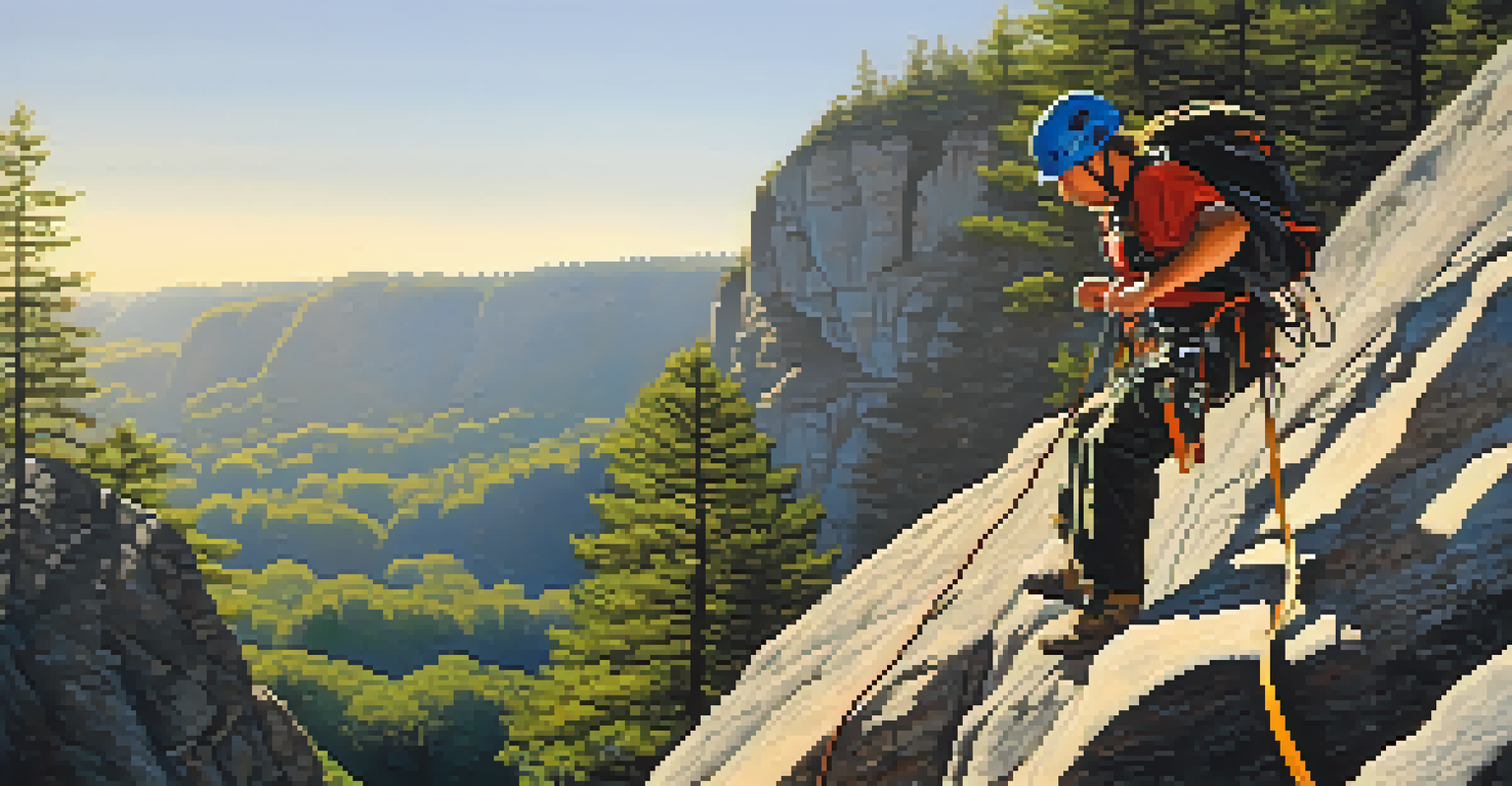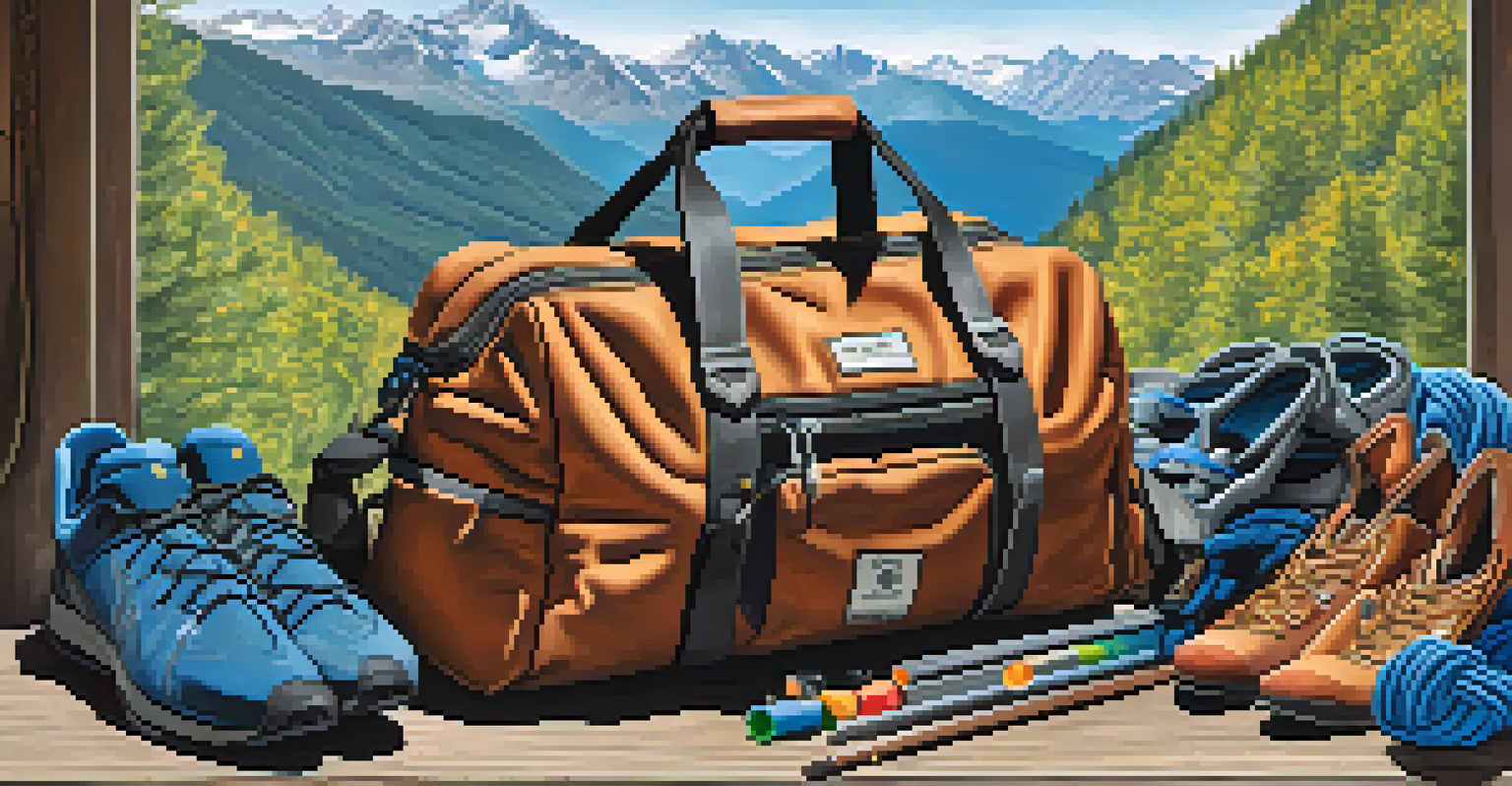Essential Gear for Thrilling Rock Climbing Adventures in India

Climbing Shoes: The Foundation of Your Ascent
Climbing shoes are arguably the most important piece of gear you'll own. They provide the grip and support you need to tackle those challenging routes. A good fit is essential; shoes that are too loose will hinder your performance, while overly tight ones can be uncomfortable and distracting.
The best climber in the world is the one who has the most fun.
When selecting climbing shoes, consider the type of climbing you'll be doing. For sport climbing, opt for a shoe with a downturned shape that maximizes precision on small footholds. For bouldering, a snug fit with a rubber sole will enhance your stability and performance on overhangs.
Don't forget to break in your climbing shoes before hitting the rock face. Spend some time wearing them around the house or at the climbing gym to avoid discomfort during your actual climbs!
Harness: Safety and Comfort Combined
A climbing harness is your lifeline when scaling heights, so choosing the right one is crucial. Look for a harness that fits snugly but allows for movement. It should sit comfortably around your waist and legs without digging in during long climbs.

There are different harness styles catering to various climbing disciplines. For rock climbing, a sport harness with gear loops is ideal, while a more minimalist approach works well for bouldering. Always check for features like adjustable leg loops to enhance comfort and flexibility.
Choose Climbing Shoes Wisely
The right climbing shoes are crucial for grip and performance, tailored to your climbing style.
Lastly, always inspect your harness for wear and tear before each climb. A well-maintained harness can make all the difference in ensuring your safety on the rock face.
Chalk: Grip Booster for Your Hands
Chalk is a rock climber's best friend, helping to absorb sweat and enhance grip. It's essential for maintaining control, particularly on hot days or during strenuous climbs. Using chalk effectively can mean the difference between a successful ascent and a slippery fall.
Climbing is not just about reaching the top; it's about enjoying the journey and learning along the way.
You can choose from loose chalk or chalk balls, depending on your preference. Loose chalk offers a quick application, while chalk balls provide a more controlled release, helping you avoid chalk dust in the air. Both have their advantages, so it's worth trying out each type.
Remember to keep your chalk in a chalk bag for easy access. It’s a small yet vital component of your climbing gear, ensuring that your hands stay dry and your grip remains strong throughout your adventure.
Climbing Helmet: Your Head's Best Protection
Safety should always be a top priority when climbing, and a helmet is essential for protecting your head from falling rocks or accidental bumps. A good helmet should fit snugly and be lightweight, ensuring you barely notice it's there while you climb.
When choosing a climbing helmet, look for features like ventilation for warmer climates and a secure chin strap. There are also two main types: hard-shell helmets, which offer maximum protection, and foam helmets, which are lighter but may not provide as much impact resistance.
Harness Safety is Essential
A well-fitting harness ensures safety and comfort, allowing for better movement during climbs.
Always replace your helmet after a significant impact or after a few years of use, as materials can degrade over time. Protecting your head is non-negotiable, and a reliable helmet is a fundamental part of your climbing gear.
Ropes: The Lifeline of Your Climbing Journey
In rock climbing, your rope is your lifeline, making it essential to choose the right one for your adventure. Dynamic ropes are designed for climbing, absorbing the energy of a fall, while static ropes are used mainly for rappelling or hauling gear. Knowing the difference can enhance your safety.
For sport climbing, a rope with a diameter of 9.5 to 10.5 mm is typically recommended, while bouldering often requires a shorter rope or none at all. Always check for a rope's UIAA certification to ensure it meets safety standards.
Lastly, take care of your ropes by storing them properly and inspecting them for damage regularly. A well-maintained rope can last for years, providing you with the confidence to tackle even the toughest climbs.
Belay Device: Essential for Your Climbing Partner
A belay device is crucial for ensuring the safety of your climbing partner, allowing you to manage the rope effectively during ascents and descents. There are various types of belay devices, each with its advantages. Tube-style devices are popular for their versatility, whereas assisted braking devices provide extra safety for beginners.
When choosing a belay device, consider the rope diameter and intended use. Some devices work better with thicker ropes, while others are designed for thinner ones. Familiarize yourself with how your device works before you head out to avoid any mishaps.
Proper Gear Organization Matters
A good climbing gear bag keeps your equipment organized and accessible, enhancing your overall climbing experience.
Lastly, always practice with your belay device in a safe environment before using it on a climb. Knowing how to handle your belay device can provide peace of mind and enhance the overall climbing experience.
Approach Shoes: Transitioning from Trail to Rock
Approach shoes are designed to help you navigate the terrain leading up to your climbing destination. These versatile shoes strike a balance between hiking and climbing footwear, offering comfort for long walks and grip for scrambling over rocks. A good pair of approach shoes will make your transition from trail to rock seamless.
When selecting approach shoes, look for features like a sticky rubber sole for traction, a comfortable fit for hiking, and a durable upper to withstand rough conditions. Many options also come with added ankle support, which can be beneficial for uneven terrain.

Remember, the right approach shoes can make your journey to the climbing site much more enjoyable. They not only provide comfort but also ensure that you’re ready to tackle the rock face when you arrive.
Climbing Gear Bag: Organizing Your Essentials
A good gear bag is essential for keeping all your climbing equipment organized and easily accessible. Look for a bag with ample space and compartments to store your shoes, harness, chalk, and other essentials. A well-organized bag can save you time and frustration when prepping for a climb.
Consider a climbing backpack that’s not only spacious but also comfortable to carry. Features like padded straps, a hip belt, and even a hydration reservoir can enhance your climbing experience. It's also helpful if the bag is weather-resistant to protect your gear from the elements.
Lastly, regularly clean and inspect your gear bag. Keeping it in good condition ensures that your climbing essentials are always ready for the next adventure, allowing you to focus on what really matters: the climb.